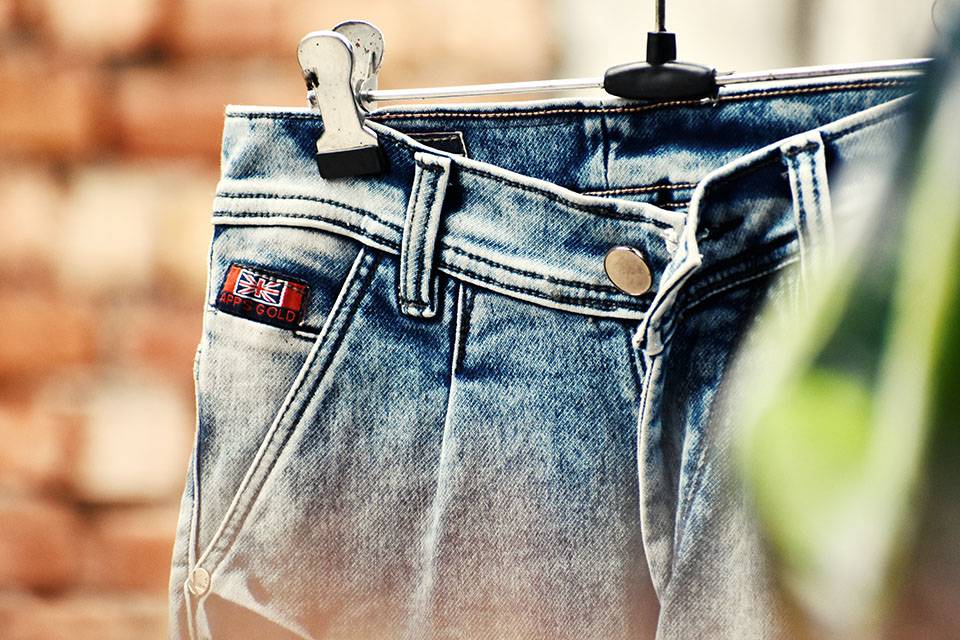How many of us remember our first jeans purchase?
My first ever jean was gifted to me by my friend Mr. P around 15 years back. Coincidentally it also happened in the same month as this article is being published.
Having sky-blue color jeans in our wardrobe was a dream for many of us a couple of decades ago. Affording a pair of jeans in those times was difficult for many. Whereas the present scenario is completely different. Thanks to the economic growth of individuals & to modern value retail segments which made the same available at much cheaper rates.
isn’t it?
Remember those days when we admired the advertisement of Newport & Ruf and Tuf jeans by actor Akshay Kumar. It was a true inspiration for many of us for buying Jeans. It is one of those products for which we will not be happy to have it made by a tailor. Buying fabric and stitching it, does not give the kind of feel and finish, wash effect of the ready garments being sold in a retail store.
Not the same, something similar
Though we belong to the textile and apparel ecosystem, as a product we like Jeans very much. We often use plenty of words to describe denim & hear from others as well. When it comes to the real meaning of it, we may have an understanding which is not exactly right. It is something similar most of the time.
I have come across several scenarios where the people from design, product, marketing, and sometimes bosses talk at length and in detail about those things but without the right understanding. We all will have some sort of understanding which might not be right always.

Difference between Denim and Jeans?
This is one interesting question to ask ourselves to check whether we have the right understanding about the same or not. Then we can refer to the below whether what we understand is right or not?
The exact difference between denim and jeans is that denim is a fabric and jeans are the garments. Denim fabric is used to make a wide variety of garments, including jackets, overalls, shirts, and jeans. Jeans are a type of garment commonly made from denim cloth. Some manufacturers use cotton to make jeans that are lighter and more breathable than the denser denim.
When these questions arose in my mind, I decided to share more about denim which made me write this article to refresh our memories and keep things in the right understanding and as simple as possible.

A-Z of Denim
Acid Wash
is a wash process that uses sponges or pumice stones soaked in chlorine to give high contrast. It is also known as marble, moon, or snow wash.
Bartack
Tiny bits of thick hand- or machine-made stitches used as reinforcements in areas like pocket openings, fly openings, or buttonholes.
Chambray
This lightweight plain weave cotton is a great alternative to thick denim in the summer. It’s made with a single-colored warp and white weft (not necessarily indigo), which gives it that light blue color.
Denim
Denim is a strong cotton fabric made using a twill weave with indigo dye resulting in its characteristic blue-cotton color. After denim is colored, manufacturers can wash, rinse, or distress the fabric to produce a wide array of denim, from dark wash to light which is the beauty of the denim.
Enzyme Wash
Enzymes are proteins that act as catalysts to increase the speed of chemical processes. It is an eco-friendly alternative to the stonewash, enzymes are used to help eat away at the indigo dye, rather than using pumice stones to beat away at the fabric.
Flat Fell Seam
It is like the double needle stitch, flat felt seams use two needles for the inseam of jeans, which makes it strong and durable. Look at the seams of your jeans — the parallel stitch lines are called a flat felt seam.
Grinding
Another form of surface abrasion, grinding is applied to the pocket edges and bottom hem to create that frayed, worn-out effect.
Hand Sanding
Hand sanding, which falls under dry process and abrasion, is how brands get their styles to look super worn-in and vintage without the aging process.
Indigo
Dates to ancient times when it was organically extracted from plants for cotton weaves (which is how the “blue” jean got its distinctive color). Nowadays indigos are synthetically created. Indigo is a deep color close to the color wheel blue. The word "indigo" comes from the Latin for Indian as the dye was originally exported to Europe from India.
Jeans
Jeans are casual-wear pants typically made from denim fabric. Patented in the nineteenth century in the United States by Levi Strauss and Jacob Davis, a typical pair of jeans usually features a button clasp, a zipper, belt loops, and front and back pockets, with copper rivets to reinforce the pockets.
Often called blue jeans or denim jeans, many jeans are made from indigo denim and come in a range of blue colors; other standard colors include black, grey, and white.
Knee Bursts
These adorable, star-like lines that appear at the knees are called knee bursts.
Laser Whiskers
Since hand-sanding tends to be so labor-intensive, lasers are often used to create the same abrasion and grinding effects since it’s faster, more precise, cheaper, and oftentimes, more eco-friendly.
Monkey Bleach
Monkey bleach is defined as a placement bleach that adds a vintage look to jeans.
Natural Fibers
These are fibers that come straight and unfettered from the earth. The most important and widespread fiber is cotton. These Genetic cropped jeans are made of 98% organic cotton & 2% elastane.
Oxidization
This is a natural process where chemical reactions change the surface characteristics of jeans due to materials being exposed to oxygen.
Power Stretch
Power stretch is the term that is applied to fabrics with superior bounce-back recovery so silhouettes don’t lose too much shape after a ton of wear. Depending on the color, these power stretch skinnies feature anywhere from 88%-93% cotton, 5-8% polyester, and 2-4% spandex for ultimate jegging-like movement but with the recovery of denim.
Quick-Dry
Quick-dry isn’t a true “technical” term, but the performance denim with water-resistant technology. The surface tension is reduced because paraffin chains (a water-resisting product) are wrapped around every fiber in the denim — water droplets just runoff. And any moisture that does get trapped simply wicks away quickly.
Resin
Resin is the tree sap that you’re already familiar with, but in denim-making, it is used to hold the color or the shape of 3D-manipulated denim.
Stonewash
Stonewash is the treatment where pumice stones are added to the wash cycle with the denim to lighten up jeans.
Tinting
This is the process of adding a little bit of color to give a pair of jeans a slightly different shade.
Unwashed
Unwashed jeans — which have skipped the laundry process — are known for their raw and stiff fabric that is fun to break into.
Vintage
While “vintage” is not a technical term, anything that’s about 20 years old or older in denim context is called Vintage. Re/Done jeans which are repaired and restructured to fit the modern-day body.
Whiskering
The fading of the ridges increases around the crotch area and the back of the knees are affectionately known as whiskers. These lines are used to give the appearance of aged denim.
X-Tra Long Inseams
While there isn’t a true technical term for extra-long inseams, the mechanics of creating jeans proportionate for taller girls are worth a mention. For example, these 40” inseam feature a high knee break, a higher rise, and billow out to skim the ground (to cover a platform shoe).
Yoke
Flip jeans around to the backside and you’ll see the yoke — the triangular, V-shaped seam below the waistband that gives curve and shape to the butt area.
Z-Twist
The Z-twist literally refers to the Z-shape direction of how the denim yarn is spun — in a clockwise direction so that if you see it from any angle, the fibers angle slightly to the right. Most denim yarns are Z-twist.
Hope you had a chance to rejig memories of your first ever Jeans purchase & able to get a better understanding of denim and jeans and the words we often use & hear about denim in our professional life. Happy learning!
Look forward to your feedback, thoughts & continued support by reading the articles and sharing them with others.
RELATED TOPICS:#Apparel,Ramesh Gunasekaran
Leave a comment
Our email address will not be published. Required fields are marked *







15 Comments
BktOct 03, 2022 at 14:47 pm
Article wrjting is also a excitement, if yyou khow then you can wrie otherwise it iss difficult tto write.
ManvendraMay 13, 2021 at 21:54 pm
Good one , this is the best article i found till date for mind opening on actually what " Jeans are" expecting more such , in depth article in coming time
Ankita LashkeryMay 07, 2021 at 12:49 pm
You do a very good effort in explaining things and you have successfully acheived it ! Amazing !
AnandMay 06, 2021 at 07:57 am
Excellent articulation of difference between denim and jeans. As also A-Z throws up a lot of understanding in getting to know jeans and denim fabrics. Probably can b used as material to educate prospective customers and as CSA training material. Feel good factor reminiscing the first pair of jeans worn , beautiful memories of good old days. Thankyou Ramesh ?
AnbazhaganMay 04, 2021 at 13:34 pm
Hi Mr.Ramesh - Again & again your astonishing article on every subjects is suburb, here nomenclature of alphabetical way is really great and useful for any common person
SainathMay 02, 2021 at 00:15 am
Very nice article Ramesh. Keep sharing the knowledge. All the best!
MANJUNATHAN SMay 02, 2021 at 00:05 am
Very nice article Ramesh. Lot of things to learn about Jeans and Denim. For your kind information i used jeans i think after 25 only. And i never like jeans much also. Once again thanks for your arcticle regarding jeans.
NithyanandhanMay 01, 2021 at 22:24 pm
Dear ramesha Yes it took back to my old memories, when we where doing our college second year I bought my first ruf & tuf jeans, our hostel met used to wear my jeans too... Also iam really happy to see your article every time,and the way you are taking it forward and giving them in a very simple form that everyone can understand.. All best and looking forward for many articles from you macchi... Keep going on
Syed AkbarMay 01, 2021 at 15:02 pm
Nice..The article compels to ponder over the fond memories of the first jeans experience. Difference between denim and jeans . Covered A-Z of details involved in the process of Jean making.. Good one Ramesh
Dr. K SaravananMay 01, 2021 at 15:01 pm
Very nice article to read.
NagendraMay 01, 2021 at 14:50 pm
Superb and very useful .
Sakthivel.SMay 01, 2021 at 14:23 pm
Ramesh sir, nicely explained from fabric to finishing.
Sivagurunathan SMay 01, 2021 at 14:16 pm
Dear Ramesh.... First of all thanks for this subject where I trust most of us 2ould be thinking abt our first pair of jeans.... Interesting details... Thanks again
Mallikarjun BevinamadMay 01, 2021 at 14:09 pm
Very use full article
ShyjumavallyMay 01, 2021 at 12:51 pm
Good one Ramesh , your efforts to share knowledge to everyone are really appreciable ?? My memories gone back to my first ruff and tuff sky blue jean fabric , which was sold in fab form and we got it stitched ?